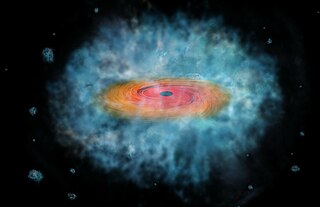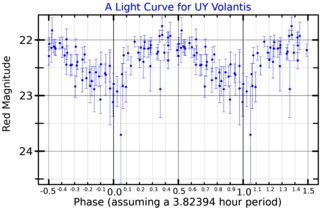Related Research Articles

Cygnus is a northern constellation on the plane of the Milky Way, deriving its name from the Latinized Greek word for swan. Cygnus is one of the most recognizable constellations of the northern summer and autumn, and it features a prominent asterism known as the Northern Cross. Cygnus was among the 48 constellations listed by the 2nd century astronomer Ptolemy, and it remains one of the 88 modern constellations.

A supermassive black hole is the largest type of black hole, with its mass being on the order of hundreds of thousands, or millions to billions of times the mass of the Sun (M☉). Black holes are a class of astronomical objects that have undergone gravitational collapse, leaving behind spheroidal regions of space from which nothing can escape, not even light. Observational evidence indicates that almost every large galaxy has a supermassive black hole at its center. For example, the Milky Way has a supermassive black hole in its Galactic Center, corresponding to the radio source Sagittarius A*. Accretion of interstellar gas onto supermassive black holes is the process responsible for powering active galactic nuclei (AGNs) and quasars.

The Galactic Center is the rotational center, the barycenter, of the Milky Way galaxy. Its central massive object is a supermassive black hole of about 4 million solar masses, which is called Sagittarius A*, a compact radio source which is almost exactly at the galactic rotational center. The Galactic Center is approximately 8 kiloparsecs (26,000 ly) away from Earth in the direction of the constellations Sagittarius, Ophiuchus, and Scorpius, where the Milky Way appears brightest, visually close to the Butterfly Cluster (M6) or the star Shaula, south to the Pipe Nebula.

In astronomy, a galactic bulge is a tightly packed group of stars within a larger star formation. The term almost exclusively refers to the central group of stars found in most spiral galaxies. Bulges were historically thought to be elliptical galaxies that happened to have a disk of stars around them, but high-resolution images using the Hubble Space Telescope have revealed that many bulges lie at the heart of a spiral galaxy. It is now thought that there are at least two types of bulges: bulges that are like ellipticals and bulges that are like spiral galaxies.

An intermediate-mass black hole (IMBH) is a class of black hole with mass in the range 102–105 solar masses: significantly more than stellar black holes but less than the 105–109 solar mass supermassive black holes. Several IMBH candidate objects have been discovered in our galaxy and others nearby, based on indirect gas cloud velocity and accretion disk spectra observations of various evidentiary strength.

Messier 110, or M110, also known as NGC 205, is a dwarf elliptical galaxy that is a satellite of the Andromeda Galaxy in the Local Group.

V343 Carinae is a blue-white star or star system in the southern constellation of Carina. It has the Bayer designation d Carinae, while V343 Carinae is a variable star designation. The star is visible to the naked eye with an apparent visual magnitude of 4.31. The distance to this object is approximately 1,440 light years based on parallax. It is drifting further away with a radial velocity of +13 km/s.
HR 3643 is a binary star system in the southern constellation of Carina. It has the Bayer designation G Carinae, with HR 3643 being the star's designation in the Bright Star Catalogue. The system is visible to the naked eye with an apparent visual magnitude of 4.48. It is located at a distance of approximately 401 light years from the Sun based on parallax, and is drifting further away with a radial velocity of +22.5 km/s.
Delta1 Lyrae, its name Latinized from δ1 Lyrae, is a binary star system in the northern constellation of Lyra. It is dimly visible to the naked eye at night with a combined apparent visual magnitude of 5.56. The system is located at a distance of approximately 1,160 light years from the Sun based on parallax, but is drifting closer with a radial velocity of −26 km/s. O. J. Eggen originally included this as a candidate member of the proposed Delta Lyrae cluster.

HW Virginis, abbreviated HW Vir, is an eclipsing binary system, approximately 563 light-years away based on the parallax measured by the Gaia spacecraft, in the constellation of Virgo. The system comprises an eclipsing B-type subdwarf star and red dwarf star. The two stars orbit each other every 0.116795 days.

A0620-00 is a binary star system in the constellation of Monoceros, with an apparent magnitude of 11.2

52 Herculis is a triple star system in the northern constellation of Hercules. It is visible to the naked eye as a faint point of light with a combined apparent visual magnitude of 4.82. Based upon parallax measurements, the system is located 180 light years away from the Sun. It is moving closer to the Earth with a heliocentric radial velocity of −1.6 km/s.

NGC 7090 is a spiral galaxy in the southern constellation of Indus located about 31 million light-years away. English astronomer John Herschel first observed this galaxy on 4 October 1834.

Pi5 Orionis (π5 Ori, π5 Orionis) is a binary star system in the constellation Orion. It has an apparent visual magnitude of 3.69, which is bright enough to be visible to the naked eye on a clear night. Based upon an annual parallax shift of 2.43 mas, it is around 1,300 light-years distant from the Sun.

N6946-BH1 is a disappearing giant star in another galaxy, NGC 6946, on the northern border of the constellation of Cygnus. The star, either a red supergiant or a yellow hypergiant, was 25 times the mass of the sun, and was 20 million light years distant from Earth. In March through to May 2009 its bolometric luminosity increased to at least a million solar luminosities, but by 2015 it had disappeared from optical view. In the mid and near infrared an object is still visible, however, it is fading away with a brightness proportional to t−4/3. The brightening was insufficient to be a supernova, and is called a failed supernova.

NGC 4299 is a featureless spiral galaxy located about 55 million light-years away in the constellation Virgo. It was discovered by astronomer William Herschel on March 15, 1784 and is a member of the Virgo Cluster.
WASP-25 is a yellow main sequence star in the constellation of Hydra.

Direct collapse black holes are high-mass black hole seeds, putatively formed within the redshift range , when the Universe was about 100–250 million years old. Unlike seeds formed from the first population of stars (also known as Population III stars), direct collapse black hole seeds are formed by a direct, general relativistic instability. They are very massive, with a typical mass at formation of ~105 M☉. This category of black hole seeds was originally proposed theoretically to alleviate the challenge in building supermassive black holes already at redshift , as numerous observations to date have confirmed.

UY Volantis, also known as EXO 0748-676, is a low mass X-ray binary system located in the constellation Volans. With an apparent magnitude of 16.9, it requires a powerful telescope to see. With a radial velocity of 20 km/s, it is drifting away from the Solar System, and is currently located 26,000 light years away.
References
- 1 2 3 "MAXI J1659-152". SIMBAD . Centre de données astronomiques de Strasbourg . Retrieved 2021-03-01.
- 1 2 Corral-Santana, Jesús M.; Torres, Manuel A P.; Shahbaz, Tariq; Bartlett, Elizabeth S.; Russell, David M.; Kong, Albert K H.; Casares, Jorge; Muñoz-Darias, Teodoro; Bauer, Franz E.; Homan, Jeroen; Jonker, Peter G.; Mata Sánchez, Daniel; Wevers, Thomas; Rodríguez-Gil, Pablo; Lewis, Fraser; Schreuder, Laurien (2018). "The long-term optical evolution of the black hole candidate MAXI J1659−152". Monthly Notices of the Royal Astronomical Society. 475: 1036–1045. arXiv: 1712.02349 . doi:10.1093/mnras/stx3156.
- ↑ Jonker, P. G.; Miller-Jones, J. C. A.; Homan, J.; Tomsick, J.; Fender, R. P.; Kaaret, P.; Markoff, S.; Gallo, E. (2012). "The black hole candidate MAXI J1659-152 in and towards quiescence in X-ray and radio". Monthly Notices of the Royal Astronomical Society. 423 (4): 3308–3315. arXiv: 1204.4832 . Bibcode:2012MNRAS.423.3308J. doi:10.1111/j.1365-2966.2012.21116.x. S2CID 19065997.
- ↑ Astronomers Just Found a Star Orbiting a Black Hole at 1 Percent the Speed of Light (2017)
- ↑ MAXI J1659-152: The shortest orbital period black-hole transient in outburst (2012)